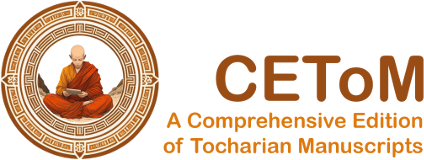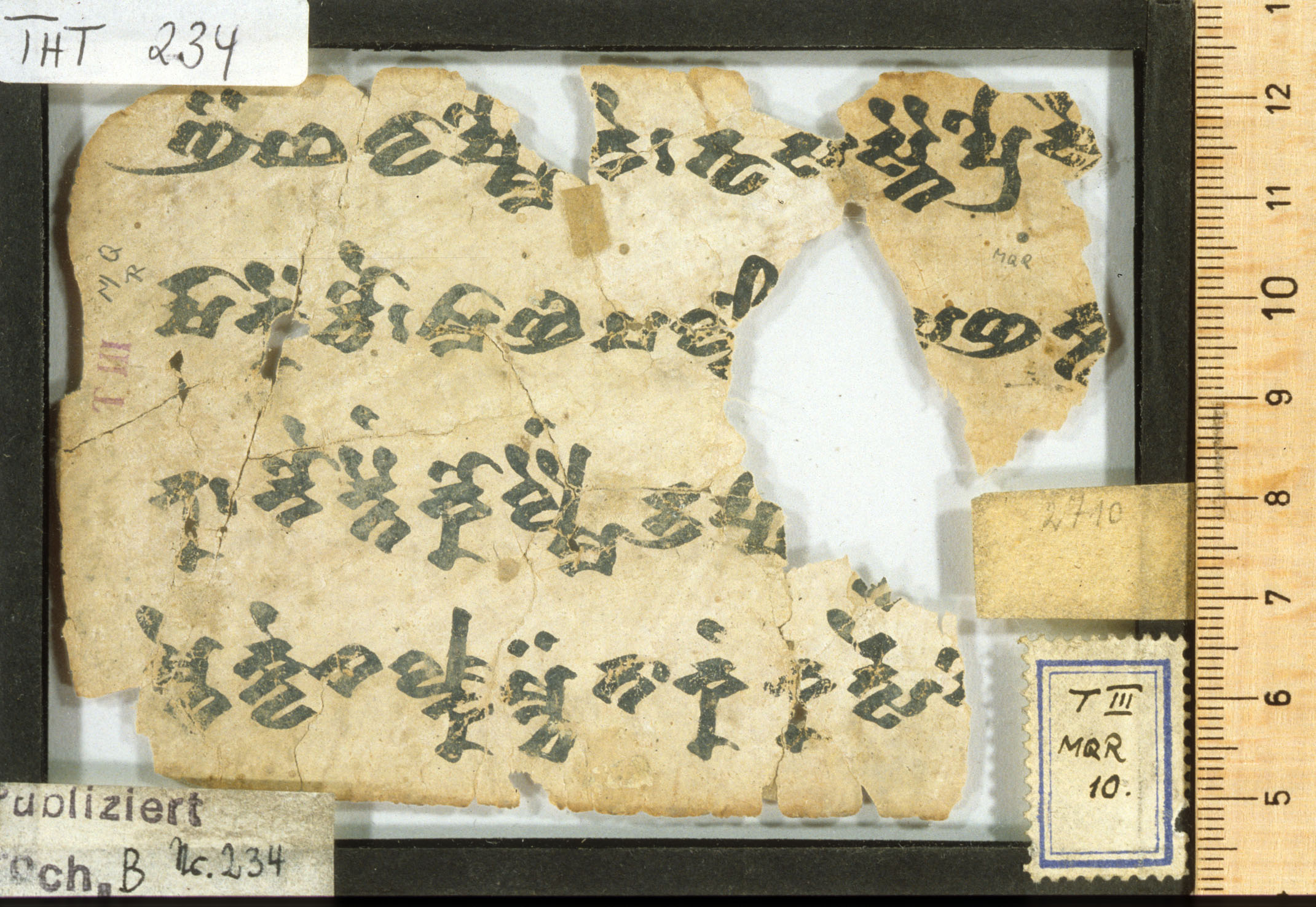THT 234
| Known as: | THT 234; B 234; Bleistiftnummer 2710 |
|---|---|
| Cite this page as: | "THT 234". In A Comprehensive Edition of Tocharian Manuscripts (CEToM). Created and maintained by Melanie Malzahn, Martin Braun, Hannes A. Fellner, and Bernhard Koller. https://cetom.univie.ac.at/?m-tht234 (accessed 01 Jul. 2025). |
Provenience | |
| Main find spot: | Kizil Ming-öy |
| Specific find spot: | Rothkuppelraum |
| Expedition code: | T III MQR 10 |
| Collection: | Berlin Turfan Collection |
Language and Script | |
| Language: | TB |
| Linguistic stage: | classical |
| Script: | classical |
Text contents | |
| Text genre: | Literary |
| Text subgenre: | Buddhastotra |
| Verse/Prose: | verse |
Object | |
| Manuscript: | THT 234-236 |
| Material: | ink on paper |
| Form: | Poṭhī |
| Number of lines: | 4 |
Images
Images from idp.bl.uk by courtesy of the International Dunhuang Project, the Berlin-Brandenburgische Akademie der Wissenschaften, and the Staatsbibliothek zu Berlin – Orientabteilung.
Transliteration
| a1 | ñä¯ ¯ś wā ṣmo ne : tū sa snai pro s[kai] /// |
|---|---|
| a2 | rṣā keṃ cai : mā ñi pa l·o – sa ña kta /// |
| a3 | nu : nau ntaiṃ ko lmaiṃ u ppā· [t]· /// |
| a4 | mte kwe¯ ¯s lkā¯ ¯mcä tā kaṃ ka rtse [po] /// |
| lf | 80 4 |
| b1 | da tteṃ ka rtse ya ma stwa lo twe [:] /// |
| b2 | rña kta lo ka lymi : ai ka ·e /// |
| b3 | ñlā re pe lai kne : tā kau – ·ṣ· rmtsa t· /// |
| b4 | ya po yi ṣwa rka : pe lai kn· ṣṣe wa /// |
Transcription
| lf | 80-4 |
| a1 | ñäś wāṣmone : tūsa snai proskai /// |
|---|---|
| a2 | rṣākeṃ cai : mā ñi pal(sk)o – sa ñakta /// |
| a3 | nu : nauntaiṃ kolmaiṃ uppā(ln) t(a) /// |
| a4 | mtek wes lkām-c tākaṃ kartse po /// |
| b1 | datteṃ kartse yamast walo twe : /// |
| b2 | r ñakt= alokälymi : aika(r)e /// |
| b3 | ñ lāre pelaikne : tākau – ·ṣ(a)rmtsa t· /// |
| b4 | yapoy iṣwarka : pelaikn(e)ṣṣe wa /// |
Translation
| a4 | If we see you there, then it is good ... all ... |
|---|---|
| b1 | Toi, ô roi, tu fais le bien. |
Other
| a4 | If we see you there, then it is good … all … (Peyrot 2013b: 669) |
|---|
References
Online access
Edition
Translations
Meunier 2013: b1 (181); Peyrot 2013b: a4 (669); Thomas 1997: a4 (79)
Bibliography
“The International Dunhuang Project: The Silk Road Online.” n.d. http://idp.bl.uk.
Meunier, Fanny. 2013. “Typologie des locutions en yām- du tokharien.” Tocharian and Indo-European Studies 14: 123–85.
Peyrot, Michaël. 2013b. The Tocharian subjunctive. A study in syntax and verbal stem formation. Vol. 8. Brill’s Studies in Indo-European Languages & Linguistics. Leiden/Boston: Brill.
Sieg, Emil, and Wilhelm Siegling. 1953. Tocharische Sprachreste. Sprache B, Heft 2. Fragmente Nr. 71-633. Edited by Werner Thomas. Göttingen: Vandenhoeck & Ruprecht.
Thomas, Werner. 1997. Interpretationsprobleme im Tocharischen. Unflektiertes A puk, B po “ganz, all, jeder”. Vol. 3. SbWGF, XXXV. Stuttgart: Steiner.
Gippert, Jost, Katharina Kupfer, Christiane Schaefer, and Tatsushi Tamai. n.d. “Thesaurus Indogermanischer Text- und Sprachmaterialien (TITUS): Tocharian Manuscripts from the Berlin Turfan Collection.” http://titus.fkidg1.uni-frankfurt.de/texte/tocharic/thtframe.htm.




